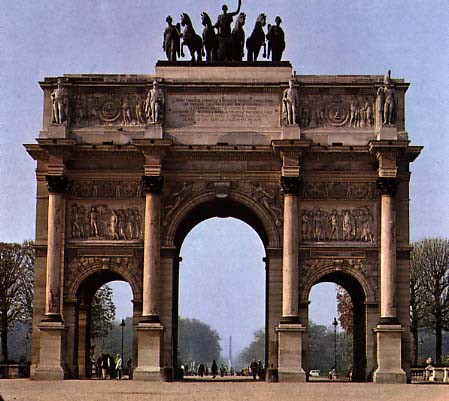The Arc de Triomphe du Carrousel (firmly anchored to the tradition of the ancient triumphal arches) was built by Percier and Fontaine in circa 1806 to 1808 to celebrate the Napoleonic victories of 1805, and it was originally intended as a monumental entrance to the Tuileries palace. When that palace was destroyed by fire in 1871, it was generally agreed that the arch stood well on its own; nor was the palace greatly missed in that an exceptional view of the Champs-Elysées had been opened up.
The proportions of the arch were directly drawn from those of the Arch of Septimius Severus in Rome; furthermore Percier and Fontaine deliberately copied ancient decorative motifs of Corinthian columns in red and white marble, bas-reliefs depicting the major events of the campaign and a chariot pulled by four horses at the top. Each of the eight columns has (above it) a statue of a soldier of the Grand Army, namely: a dragoon, an infantry grenadier, a cavalry chasseur, a grenadier, a gunner, a rifleman and a sapper. The bas-reliefs illustrate the following events: (facing the Louvre) “The Surrender at Ulm” by Cartellier and “The battle of Austerlitz” by Esparcieux; (facing the rue de Rivoli) “Napoleon entering Munich” and “Napoleon bringing back the King of Bavaria” by Clodion; (facing the Tuileries Gardens) “Napoleon entering Vienna” by Deseine and “The Meeting of the two Emperors” by Ramey; (facing the Seine) “The Peace of Presbourg” by Lesueur.
Originally, “The Horses of Saint Mark's”, the famous bronzes removed from the Basilica in Venice, crowned the building, but these originals were sent back to Venice in 1815 and replaced by copies, and the statue group was completed by an allegory of the Restoration surrounded by two Victories by Bosio.
Karine Huguenaud
Trans. P.H.


